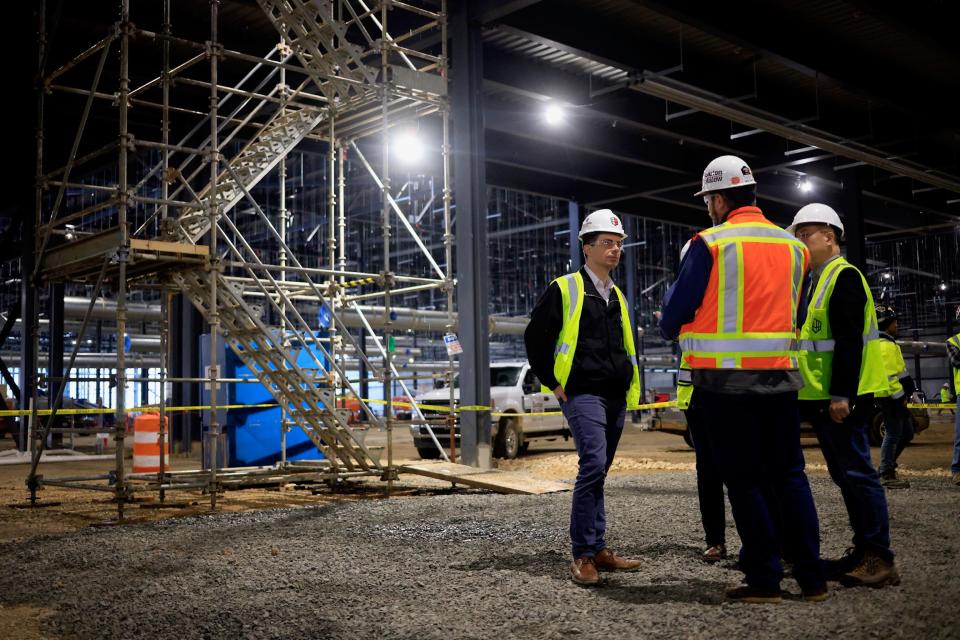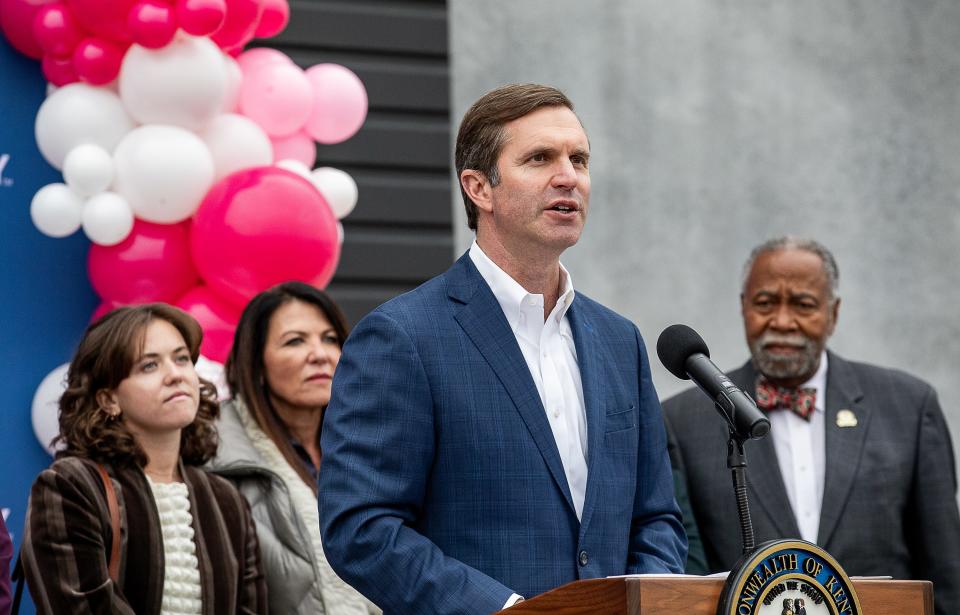Economy on fire? Here's a look at Beshear and Cameron claims on Kentucky jobs, employment

- Oops!Something went wrong.Please try again later.
- Oops!Something went wrong.Please try again later.
- Oops!Something went wrong.Please try again later.
Kentucky Gov. Andy Beshear has said many times over the past three years that Kentucky's economy is "on fire" as the COVID-19 pandemic fades in our rear-view mirror, citing record high economic investments and record low unemployment.
Attorney General Daniel Cameron, the governor's Republican opponent in his reelection race, paints a picture of the state's economy that more resembles a house burning down, saying there are fewer Kentuckians employed today and the state has a woeful workforce participation rate and falling real income.
So, who has the correct interpretation of Kentucky's economic recovery since the March 2020 onset of the pandemic?
According to federal statistics and a University of Kentucky economics professor, while specific claims of both candidates mostly ring true, the reality lies in a gray area of conflicting statistics and survey methods, along with trends that long pre-date the pandemic.
Beyond conflicting statistics and surveys, Ken Troske, an economics professor and chair at UK's Gatton College of Business and Economics, told The Courier Journal it's foolhardy to pin all of a state's economic success or failure on an elected official.
"Politicians get too much credit when things are going well and too much blame when things are going poorly," Troske said.
Here's a detailed look at the specific economic claims of the two candidates for governor, what federal and state statistics actually show, and why even economists are skeptical of relying on some of those figures.
Employment, jobs and 'gray' data
Unveiling the 10 economic principles of his future administration in a press conference this summer, Cameron struck a familiar theme for his campaign, saying "there are fewer Kentuckians working today than when Andy Beshear took office," while blaming him for Kentucky having "one of the lowest workforce participation rates in the country."
According to the current population survey of households conducted monthly by the U.S. Bureau of Labor Statistics (BLS), Cameron is correct that fewer people in the state indicate they are employed — 1,966,987 in the last survey in August, which is nearly 12,000 less than the 1,978,980 employed in February 2020, the last full month before the pandemic hit.
Earlier that summer, Beshear had erroneously claimed that more than 2 million Kentuckians were then employed for the first time in state history, though he was actually citing a different federal survey of Kentucky employers by the BLS, which measured how many nonfarm jobs they have filled on their payroll. The last employer survey in August found well over 2 million jobs filled, 68,200 more than the survey from Feb. 2020.
Compared with other states' employment recovery out of the pandemic, these two federal surveys purport to show similar statistics, yet show very different outcomes in Kentucky.
For the household survey of people employed, Kentucky is one of just 14 states that still has fewer people employed since the onset of the pandemic, with just nine states having worse than Kentucky's half-percent decrease in employment.
However, the federal employer survey shows much better job growth relative to other states, as Kentucky's 3.5% growth in this period ranks 15th among states and above the 3% national average. Among the seven bordering states, only Tennessee performed better in such job growth.
So which federal survey is a better indicator of Kentucky's job climate? Troske says economists still haven't come to a consensus on this, nor why such discrepancies occur.
Troske cited the 2004 presidential election when President George W. Bush was running for reelection, with the federal survey of households showing a small drop in the number of people employed, but the federal survey of employers showing a massive decrease in filled jobs.
"A bunch of people did some studies to say, 'Hey, what accounts for the difference?' And the results of those studies back then was: 'We don't know.'" Troske said. "Let's roll forward 20 years, and the answer to that question is: 'We still don't know.' And it's really disappointing."
One possible explanation for the higher jobs figure in Kentucky is it shows people are increasingly working multiple jobs. The Cameron campaign put forward that explanation, saying in a press release that Beshear "continues to tout numbers showing Kentuckians are having to work multiple jobs to make ends meet as an economic achievement."
Troske said multiple job holders may be a factor, but he honed in on the increasing challenge of getting responses from the current population survey of households — which also asks households for their income. The already decreasing response rate fell dramatically further during the pandemic.
"Basically, people stopped telling the government how much they're making, which means that those numbers became less accurate," Troske said. "So when you start comparing numbers of people in Kentucky with the nation as a whole, it could be just simply that a lot of that's due to what we would call non-response. So it just increases the error of the data and makes it less reliable."
While Troske added that the Federal Reserve "traditionally" prefers the federal employer survey, he noted firms are also increasingly less willing to respond to such surveys.
David Anderson, an economics professor at Centre College, also noted the monthly employer payroll survey has a much larger sample size — surveying 666,000 business establishments nationally, opposed to only 60,000 households — "which lends credibility to the payroll survey."
The same divergent trends of these two numbers continued with the release Thursday of the new BLS data from September, with the household survey showing the number of people employed in Kentucky fell by 6,823, but the employer survey showing the number of jobs on payroll increased by 4,900.
Unemployment and labor participation rate
In the first face-to-face debate of Kentucky's race for governor in Paducah last week, Beshear touted that Kentucky "set the lowest annual unemployment rate in our history last year, our longest period of low unemployment."
Kentucky's BLS statistics show that is correct, as its annual unemployment rate in 2022 was 3.9%. Additionally, Kentucky's unemployment rate has been between 3.7% and 4% for every month from January 2022 to this August.
But Cameron has continually countered that this low unemployment rate is misleading, saying Kentucky has "one of the lowest workforce participation rates in the country" — specifically criticizing Beshear for not working to make Medicaid eligible only to those who are employed.
Cameron is correct about Kentucky having a low percentage of working-age people who are employed or actively looking for work, though this trend is far from new in the state.
Kentucky's labor force participation rate — the percentage of those at least 16 years old who are either employed or on unemployment insurance and seeking work — was 57.6% in August, still 1 percentage point lower than it was before the pandemic and only higher than five other states, including neighboring West Virginia. Cameron said in another debate in Northern Kentucky this week that Kentucky has "the lowest workforce participation rate in the country," which is false by a large amount.
However, Troske notes Kentucky has consistently been among the bottom 10 states in labor force participation rate for decades, with both an aging population and a large percentage on disability, particularly notable in the Appalachian region decimated by the decades-long decline of its coal industry.
"That's been a constant issue that Kentucky's had," Troske said. "That hasn't changed, and it certainly didn't change in the pandemic."
Troske also added that a more useful indicator is to measure the labor participation rate among "prime age" workers between 25 and 54 years old, to better account for the fact that older workers are retiring.
Pew last observed states' workforce participation rate among such prime age workers this summer, finding Kentucky's 75.8% rate at the end of the first quarter of 2023 was also very low, tied at 45th. Pew also found this rate had dropped in Kentucky by 1.8% since the first quarter of 2020, joining roughly half of states that had not improved its rate in that period — but faring much better than the steep drops in West Virginia and Indiana.
Anderson of Centre College said Kentucky's low unemployment rate remains a "superior indicator" of the economic situation in Kentucky than total employment numbers, saying the historically low rate "means that citizens who want to work have an excellent opportunity to do so," which should "continue to boost wages and employment prospects."
Troske said Kentucky's unemployment rate is certainly low, but added: "Is it the result of anything Beshear did? No."
New economic development investments and jobs
Perhaps the most-used talking point of Beshear over the past three years is that Kentucky has broken records for the amount of economic development project investments that have been announced — closely mirroring the arguments of former Gov. Matt Bevin, whom Beshear defeated in the 2019 election.
"Since I've been governor, we set a record $27.5 billion of new investment here in Kentucky," Beshear said in the Paducah debate, adding these would bring 48,000 new jobs.
According to data provided by Kentucky Education and Labor Cabinet, those investment figures are correct, easily surpassing past investments wrangled in by Bevin and his predecessor, Gov. Steve Beshear, Andy's father.
Kentucky landed $11.1 billion in new investment announcements in 2021 — anchored by the $5.8 billion Ford electric vehicle battery plants in Glendale — which far surpassed Bevin's record year of $8.7 billion in 2017. The state nearly broke its own record the following year, with announcements of $10.4 billion of new development investments in 2022.
Over the course of four years — including an anemic pandemic year of 2020 — Kentucky landed $27.5 billion of investment announcements, surpassing both the $22.5 billion of Bevin's one term and the $19.4 billion landed in the eight years of the administration of Beshear's father.
One caveat for these numbers is that they are only announced investments for new projects, which sometimes fall through — such as the Braidy Industries project for a $1.3 billion aluminum manufacturing plant that Bevin landed that then imploded before it could be constructed. Several of the Top 100 investment projects Beshear brought in were for AppHarvest's large hydroponic greenhouses, though the company recently declared bankruptcy and its future is in doubt.
As far as projected jobs for these announced projects, they total 48,107 under Beshear, which is still shy of the 57,000 jobs projected by the Bevin administration for its announced projects — a figure the former governor repeated often as he ran for reelection.
Troske said the announcements about the large economic development investments coming to Kentucky like the EV battery plants are obviously a great sign for the economy, but "they're the same types of jobs we've had before, so there's nothing too dramatic about it."
Wages and income
Much like the two federal surveys on employment and jobs in Kentucky, there are two different figures for income and wages in Kentucky that tell very different stories.
Cameron has repeatedly criticized President Joe Biden, a Democrat, for the significant rise in inflation over the past few years as he attempts to tie Beshear to an unpopular president, while occasionally tying Beshear to a decrease in Kentuckians' household income.
In a press release last week, Cameron's campaign said that "under Biden and Beshear," such income has "plummeted," citing Federal Reserve figures showing real median household income in Kentucky has fallen 12% since he became governor, which is "more than four times the national decrease of 2.7% during this same time period."
The Federal Reserve figures cited by the campaign showed this 12.7% drop for Kentucky occurred from the beginning of 2020 to the beginning of 2022.
However, separate BLS figures from its quarterly census of employment and wages paints a different picture in Kentucky, showing workers' average weekly wage has increased from $954 in the fourth quarter of 2019 to $1,138 at the end of the first quarter this year — amounting to a 19% increase. In the year from the first quarter of 2022 to 2023, the figures show Kentucky's average weekly wage increased 9.3%, which ranks seventh among all states.
Asked which figure is the most credible indicator, Troske again said this is a gray area due to the increasing challenge of getting accurate responses to federal surveys of households.
While Kentucky's increase in average weekly wage did not factor in inflation, Troske was skeptical of the Federal Reserve data showing a 12% decrease in real household income.
"I think the economy's doing OK," Troske said. "I suspect that earnings are up, because we do tend to be a low wage state, and it turns out that over this time period, the wages of low wage workers have risen faster than the high wage workers."
Reach reporter Joe Sonka at jsonka@courierjournal.com and follow him on Twitter at @joesonka.






This article originally appeared on Louisville Courier Journal: Kentucky elections: Beshear, Cameron disagree on unemployment claims

